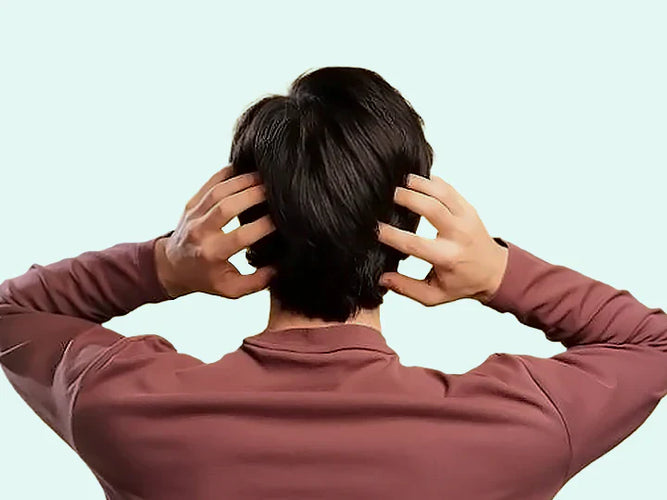Finasteride has been a well-known treatment for hair loss for decades. It was originally developed as a medicine for prostate problems but was later found to also affect hair growth. Because of this, it became a popular option worldwide for treating hereditary hair loss (androgenetic alopecia).
Many men see finasteride as a way to slow down or partly reverse their hair loss. However, that success story is not the same for everyone. The treatment works by affecting hormones, and that can come with certain risks.
What does finasteride do for hair loss?
In men with androgenetic alopecia (hereditary hair loss), hormones play a key role. The male hormone testosterone is partly converted in the body into dihydrotestosterone (DHT), a substance that affects the hair follicles.
People who are sensitive to DHT notice that their hair follicles gradually become smaller. The hair becomes thinner, grows for a shorter period, and eventually falls out.
Finasteride acts on this process. It blocks the enzyme 5-alpha-reductase, which is responsible for converting testosterone into DHT. As a result, DHT levels in the body decrease. This reduction helps protect the hair follicles, which can slow down hair loss and support new hair growth.
The effect of finasteride is scientifically proven but also temporary. Once a person stops using the medicine, DHT levels rise again and hair loss can return. Finasteride can also influence other hormone-related body functions, such as mood, libido, and sometimes energy levels.
The downside of finasteride: serious and lasting side effects
Finasteride works by affecting hormones, and this explains why its side effects can be so varied. The medicine influences not only hair growth, but also the production of substances that play a role in mood, reproduction, and fat metabolism.
The most commonly reported side effects
Official health authorities such as the EMA, FDA, NHS, and the Mayo Clinic list the following side effects that may occur when using finasteride:
Sexual side effects
- Reduced libido (less interest in sex)
- Erectile dysfunction
- Difficulty reaching orgasm or reduced semen volume
- Lower sperm quality and fertility problems
Psychological side effects
- Mood swings
- Depressive or low mood
- Anxiety or irritability
- Fatigue and trouble concentrating
Physical side effects
- Tender or enlarged breast tissue
- Skin rash, itching, or swelling of the lips and face
In rare cases, some side effects may continue even after stopping the treatment. This is known as post-finasteride syndrome (PFS). A condition in which mainly sexual and psychological symptoms may persist over time.
Why can side effects persist, even after stopping?
The exact cause of ongoing symptoms is not yet fully understood, but several explanations have been suggested. Because finasteride reduces the production of DHT for a long period, it changes the balance between different hormones and chemical messengers in the body.
As a result, the hormonal system may take longer to recover once the treatment is stopped. In some people, this recovery seems to be delayed or incomplete, which may lead to symptoms that last for months or even years.
Natural DHT blockers as an alternative to finasteride
Finasteride can be effective for hair loss, but its possible risks lead many people to look for an alternative. Those who want to support hair growth without hormonal effects often choose a non-hormonal approach using natural DHT blockers.
Instead of reducing DHT levels throughout the body, these ingredients focus on maintaining a healthy scalp and hair condition. Natural DHT blockers are often used in hair care routines or supplements designed to support the hair from the outside or from within.
The main difference lies in how they work. Finasteride is a prescription medicine that acts through the hormonal system to lower DHT levels across the body. Natural DHT blockers, on the other hand, do not have a systemic effect. They are used in cosmetic or nutritional formulas that help care for the scalp and hair in a milder, non-hormonal way.
For this reason, many people see natural DHT blockers as part of a balanced approach to maintaining healthy hair without interfering with hormones.
Examples of commonly used natural DHT-blocking ingredients
- Ecklonia Cava
- Panax Ginseng
- Nettle Extract
- Beta-sitosterol
- Red Clover Extract (Trifolium pratense)
- Isoflavones
- EGCG (Green Tea Extract)
- Saw Palmetto
For more information about these and other natural DHT blockers, visit our ingredients page.
Note: Natural DHT blockers are not medicines.
Conclusion
Finasteride has proven its effectiveness in treating hereditary hair loss, but it remains a medicine that works by affecting hormones. For some users, this works well, while others may experience unwanted side effects that affect their daily lives.
It is therefore important to weigh the possible benefits and risks carefully before starting or continuing treatment. Those who prefer a milder, non-hormonal approach can explore natural DHT blockers and hair care routines that focus on maintaining a healthy scalp and strong hair.
These natural alternatives are not a replacement for medical treatments, but they can be a helpful addition for anyone who wants to support their hair in a natural and balanced way.
Sources
Mayo Clinic. (2025). Finasteride (oral route): Side effects. https://www.mayoclinic.org/drugs-supplements/finasteride-oral-route/description/drg-20063819
National Health Service. (2024). Finasteride: Side effects and safety information. NHS UK. https://www.nhs.uk/medicines/finasteride/side-effects-of-finasteride/
Medicines and Healthcare products Regulatory Agency. (2024, April). Finasteride: Reminder of the risk, psychiatric side effects and of sexual side effects (which may persist after discontinuation of treatment). GOV.UK. https://www.gov.uk/drug-safety-update/finasteride-reminder-of-the-risk-psychiatric-side-effects-and-of-sexual-side-effects-which-may-persist-after-discontinuation-of-treatment
Mysore, V., & Shukla, A. (2012). Finasteride and sexual side effects. PMC (US National Library of Medicine National Institutes of Health). https://pmc.ncbi.nlm.nih.gov/articles/PMC3481923/
This information does not replace professional medical advice. If in doubt, always consult a doctor or specialist.













